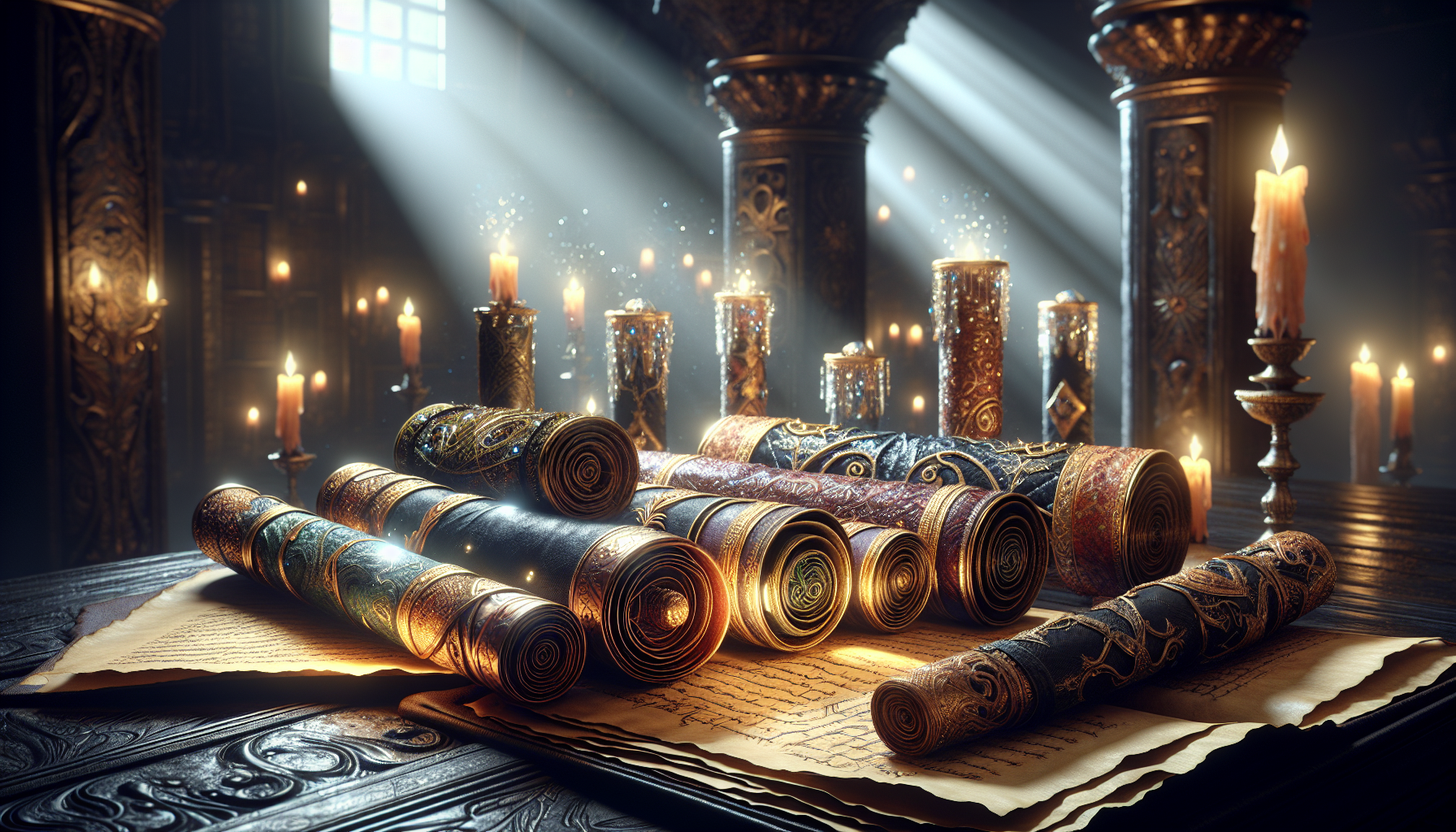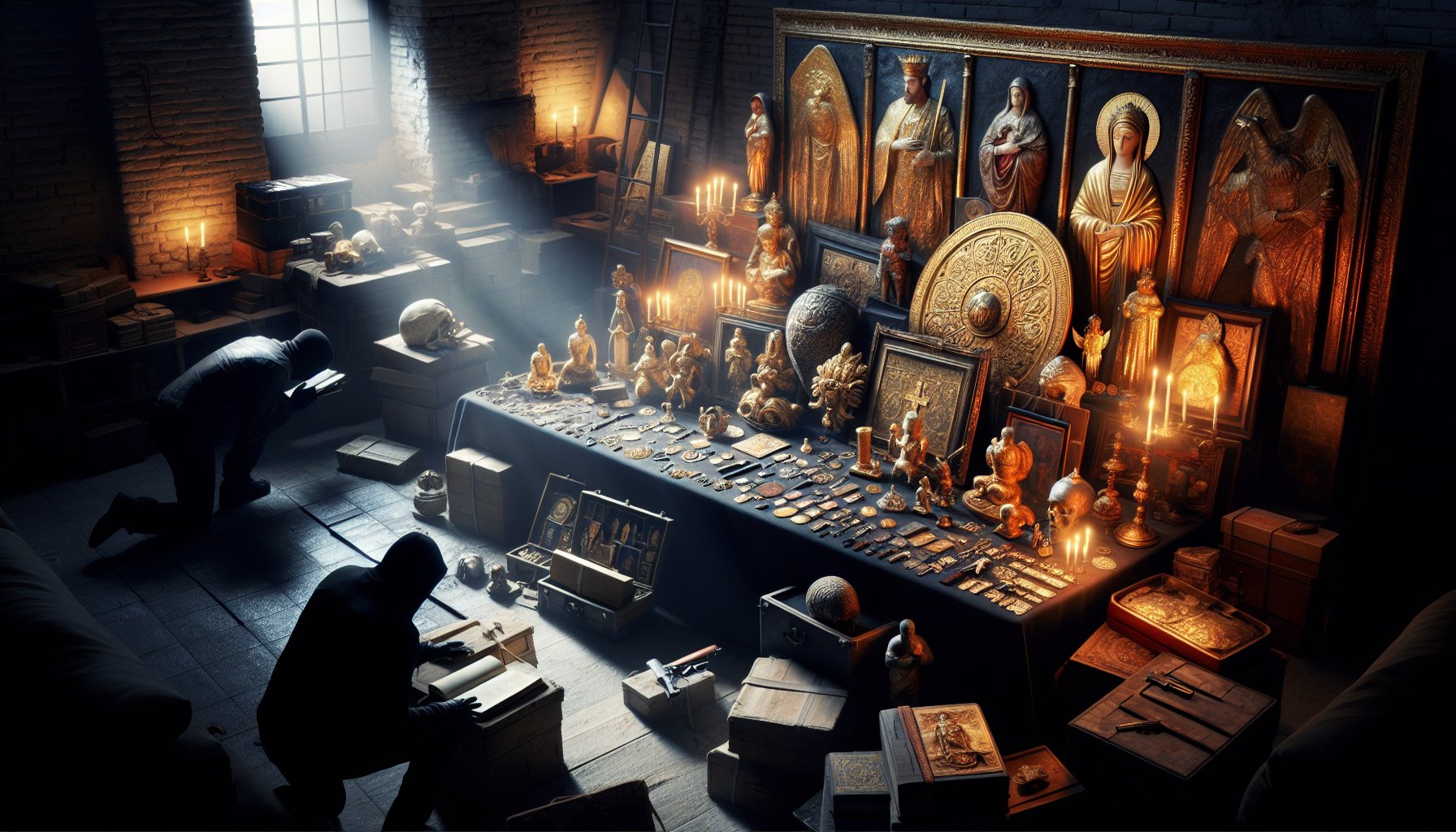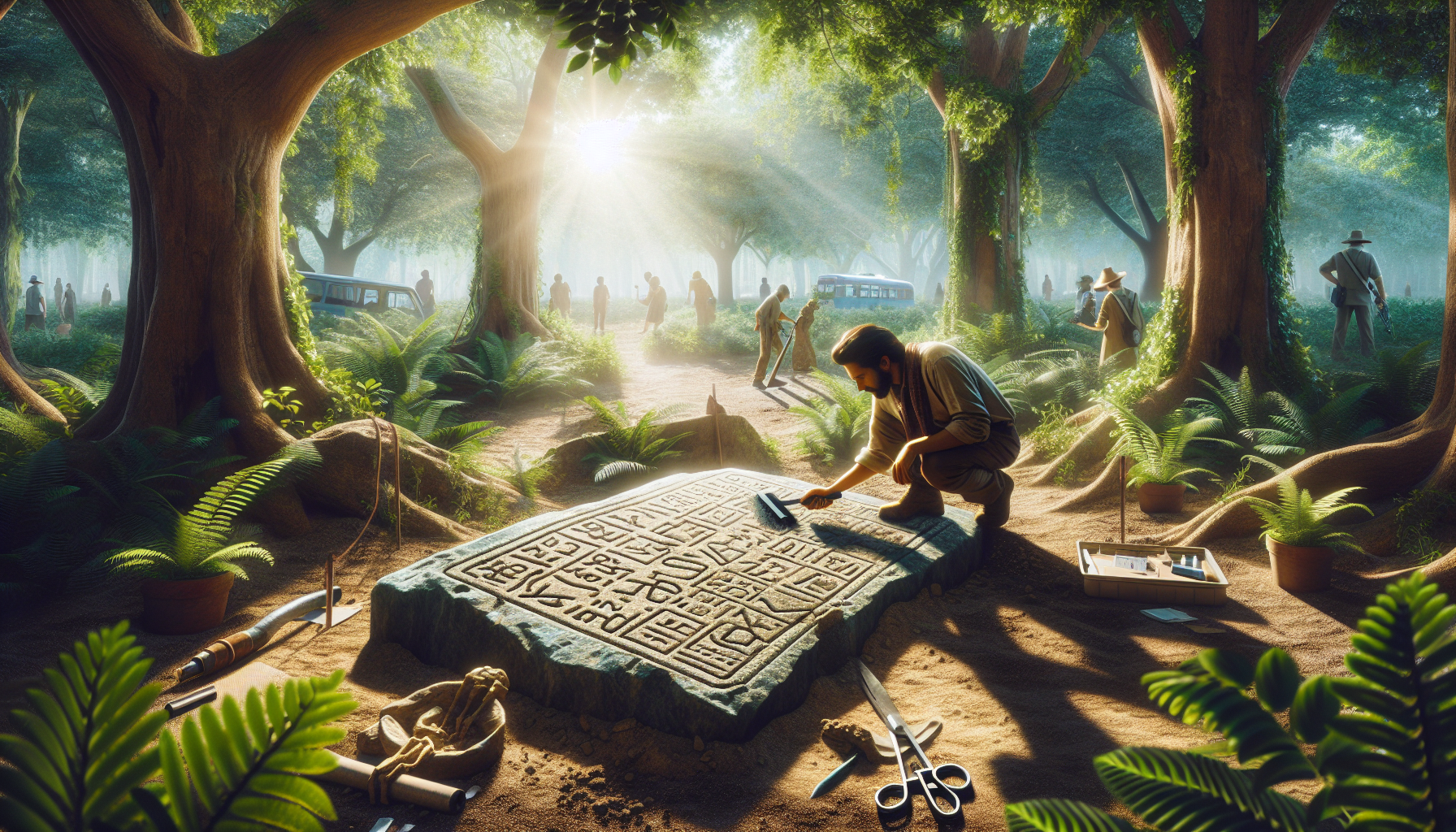In a world where digital screens and instant information reign supreme, there remains a profound allure in the tangible, the tactile, and the ancient. Imagine stepping into a dimly lit room, the air thick with the scent of aged paper and history. Before you lies a collection of scrolls, each wrapped in a material more unusual and enchanting than the last. Some are swathed in delicate silk, others in rugged leather, and a few even shimmer with metals that seem almost otherworldly. These are not merely relics of the past but gateways to realms of wisdom, mystery, and enchantment. 📜✨ This article embarks on a journey to explore the mystical scrolls ensconced in such intriguing materials, unraveling the stories they tell and the secrets they keep.
As we delve into this mystical realm, we will first explore the origins of these scrolls and their significance across different cultures and eras. From the opulent silk scrolls of ancient China to the parchment-wrapped treasures of the Mediterranean, each piece tells a story not only through its content but also through the very fabric that encases it. These materials were not chosen arbitrarily; they reflect the cultural values, available resources, and intended purposes of the texts they protect. Our exploration will also uncover the craftsmanship behind these creations, as artisans of yore employed techniques passed down through generations, imbuing each scroll with a touch of magic and a hint of the divine.
The journey doesn’t end there. We will also examine the modern implications and inspirations drawn from these ancient artifacts. In a time when technology often eclipses tradition, there is a resurgence of interest in these mystical scrolls, inspiring artists, historians, and even technologists to reimagine their potential. Could these ancient scrolls hold lessons for our contemporary lives? How might their enchanting presence influence our understanding of history and the future of storytelling? As we unveil the enchantment wrapped in these unusual materials, prepare to be transported to a world where the past and present intertwine, offering wisdom, wonder, and a touch of the extraordinary.
The Fascinating World of Mystical Scrolls
In the enchanting realm of mystical scrolls, the fusion of ancient knowledge with mysterious materials creates an aura of intrigue and fascination. These scrolls, often wrapped in unusual and exotic substances, have captured the imagination of historians, collectors, and spiritual seekers alike. The allure of these artifacts lies not only in their content but also in the materials that envelope them, each with its own story to tell.
These mystical scrolls are steeped in history, with origins tracing back to ancient civilizations where scribes and magicians inscribed them with spells, prophecies, and sacred texts. The choice of material for wrapping these scrolls was often as significant as the content itself, chosen for its symbolic meaning, protective properties, or rarity. The materials range from papyrus and vellum to silk and leather, each offering unique insights into the cultural and historical context of the scrolls.
The journey of these scrolls from their place of origin to modern-day collectors is a testament to their enduring appeal. Over centuries, they have been preserved, traded, and cherished, often passing through the hands of scholars, mystics, and antiquarians. As we delve into the world of mystical scrolls, we will explore the various materials that have been used to wrap them, the significance of these choices, and the stories they hold. Let us embark on this captivating journey, where ancient wisdom meets material mysticism.
The Enigmatic Materials of Mystical Scrolls
The materials used to wrap mystical scrolls are as varied as the cultures that created them. Each material was carefully selected for its properties, both physical and symbolic, adding an extra layer of meaning to the scrolls themselves. Among the most common materials were papyrus, vellum, silk, and leather, each offering unique characteristics and associations.
Papyrus, one of the earliest materials used for scrolls, is derived from the papyrus plant that grows abundantly along the Nile River. It was highly valued in ancient Egypt for its availability and ease of use. The significance of papyrus lies not only in its practicality but also in its association with the gods and the afterlife, as it was often used for religious texts and funerary documents. This material embodies the ancient world’s blend of spirituality and practicality, making it a popular choice for mystical scrolls.
Vellum, a type of parchment made from animal skin, was another favored material for scrolls. Its durability and smooth surface made it ideal for detailed inscriptions and intricate illustrations. Vellum scrolls were often used for important religious texts and legal documents, adding a sense of gravitas and permanence. The use of vellum highlights the importance placed on the scrolls’ content, as well as the desire to preserve it for future generations.
Comparative Table of Scroll Materials
| Material | Origin | Properties | Symbolism |
|---|---|---|---|
| Papyrus | Ancient Egypt | Lightweight, easy to produce | Associated with the divine and the afterlife |
| Vellum | Europe, Middle East | Durable, smooth surface | Signifies importance and permanence |
| Silk | China, India | Lustrous, strong, luxurious | Represents wealth and sophistication |
| Leather | Various regions | Sturdy, flexible | Protection, resilience |
Silk, known for its lustrous sheen and luxurious texture, was another material used for wrapping scrolls, particularly in East Asia. Silk scrolls were often used for important documents and artistic works, reflecting the material’s association with wealth and sophistication. The use of silk in mystical scrolls adds an element of elegance and prestige, enhancing the allure of the scrolls themselves.
Leather, a robust and flexible material, was also commonly used for scrolls. Its durability and protective qualities made it ideal for preserving valuable texts over long periods. Leather scrolls were often used for legal and religious documents, highlighting the importance of their content. The choice of leather as a wrapping material underscores the scrolls’ significance, offering a tangible sense of protection and resilience.
The Symbolism Behind the Materials
The materials chosen for mystical scrolls are imbued with symbolism, each telling its own story about the culture and beliefs of the time. This symbolism adds depth to the scrolls, offering insights into the values and priorities of the societies that created them.
Papyrus, for instance, is closely linked to the Egyptian god Thoth, the deity of writing and knowledge. This association underscores the importance of writing as a divine act, a means of preserving and transmitting sacred knowledge. The use of papyrus for mystical scrolls reflects the ancient Egyptians’ reverence for the written word and its role in connecting the physical and spiritual realms.
Vellum, derived from animal skin, carries its own symbolism related to transformation and sacrifice. The process of creating vellum involves transforming a raw material into something refined and lasting, mirroring the transformative power of the knowledge contained within the scrolls. Vellum scrolls often held texts of great significance, reflecting the belief that knowledge is both a gift and a responsibility.
The Symbolic Meanings of Materials
- Papyrus: Connection to the divine, preservation of sacred knowledge
- Vellum: Transformation, sacrifice, permanence
- Silk: Wealth, sophistication, cultural prestige
- Leather: Protection, durability, resilience
Silk, with its luxurious texture and sheen, symbolizes wealth and cultural prestige. In many cultures, silk was a material reserved for the elite, and its use in scrolls signified the importance of the document’s content. The association of silk with opulence and refinement adds an element of allure to mystical scrolls, enhancing their value as both artifacts and symbols of cultural achievement.
Leather, with its protective qualities, symbolizes resilience and durability. The use of leather for wrapping scrolls reflects a desire to safeguard the knowledge contained within, ensuring its survival through time. Leather scrolls are often associated with important legal or religious texts, underscoring the importance of preservation and the enduring nature of the knowledge they contain.
The Journey of Mystical Scrolls Through Time
The journey of mystical scrolls through time is a testament to their enduring appeal and the fascination they continue to hold. From ancient civilizations to modern-day collectors, these scrolls have been treasured for their content, craftsmanship, and the stories they tell.
Throughout history, mystical scrolls have been passed down through generations, often becoming heirlooms that carry with them the wisdom and beliefs of the past. They have been studied by scholars, revered by spiritual seekers, and sought after by collectors, each drawn to the unique combination of knowledge and mystery these scrolls represent.
The preservation and trade of mystical scrolls have also played a significant role in their journey. As they traveled from one culture to another, they brought with them the ideas and beliefs of their place of origin, contributing to the exchange of knowledge and cultural understanding. This exchange has enriched the scrolls themselves, adding new layers of meaning and context as they moved through time and space.
One fascinating aspect of mystical scrolls is the way they have been adapted and reinterpreted over time. As new materials and techniques became available, the scrolls were sometimes rewritten or rewrapped, incorporating these innovations into their design. This adaptability reflects the scrolls’ enduring relevance and their ability to resonate with each new generation.
To explore more about the materials and the journey of mystical scrolls, I recommend watching this engaging video: “The Secrets of Ancient Scrolls” by Historical Insights. This video provides an in-depth look at the fascinating world of mystical scrolls, offering insights into their history, symbolism, and the materials that have wrapped them throughout the ages.

Conclusion
In conclusion, “Unveiling the Enchantment: Mystical Scrolls Wrapped in Unusual Materials” has taken us on a fascinating journey through the enchanting world of ancient manuscripts and their intriguing coverings. As we delved into the depths of this captivating subject, we uncovered a tapestry of history, culture, and artistry that continues to inspire and awe even in today’s modern era.
Throughout the article, we explored the rich tapestry of mystical scrolls, each uniquely wrapped in materials that are as diverse as the cultures from which they originate. From the opulent silk scrolls of ancient China to the mysterious leather-bound texts of medieval Europe, each artifact offers a glimpse into the spiritual and intellectual endeavors of the past. These scrolls are not merely relics; they are vibrant links to the thoughts and beliefs of those who came before us, preserving wisdom that transcends time.
We also examined the intricate craftsmanship involved in creating these scrolls, highlighting the artistry and dedication of the scribes and artisans. Their skills ensured that these scrolls were not just carriers of information but works of art in their own right. The choice of unusual materials—be it bamboo, papyrus, or vellum—was not only practical but often imbued with symbolic significance, adding another layer of meaning to the texts they protected.
Moreover, the article shed light on the cultural exchanges facilitated by these scrolls, illustrating how they served as conduits for knowledge and inspiration across borders. They reflect the interconnectedness of human societies, showing how ideas and innovations were shared, adapted, and transformed throughout history. The journey of these scrolls is a testament to the enduring power of human curiosity and the relentless pursuit of understanding the world around us.
In emphasizing the importance of preserving these artifacts, we acknowledged the challenges faced by conservators and historians. The delicate nature of these materials requires meticulous care and advanced techniques to ensure their longevity. By preserving these scrolls, we safeguard a wealth of knowledge and a deeper understanding of our shared heritage for future generations.
The exploration of mystical scrolls wrapped in unusual materials is not merely an academic exercise; it is an invitation to reflect on the timeless human quest for knowledge, spirituality, and artistic expression. As we ponder the stories these scrolls tell, we are reminded of our own place in this continuum, encouraged to seek out wisdom in the past and apply it to the challenges of the present and future.
We invite you, dear reader, to carry forward the insights gained from this exploration. Whether you are a scholar, an artist, or simply a curious soul, there is much to be learned from the rich history encapsulated in these scrolls. Share this knowledge with others, sparking conversations that bridge the past and the present. Reflect on the beauty and wisdom contained within these artifacts, and let it inspire your own journey of discovery and creativity.
Feel free to comment below with your thoughts and reflections on this topic. Your insights and perspectives are invaluable in enriching our collective understanding. Moreover, consider sharing this article with others who might find it intriguing. By doing so, you contribute to the ongoing dialogue about our shared human heritage and the many ways it continues to shape our world.
In conclusion, the mystical scrolls wrapped in unusual materials stand as enduring symbols of human ingenuity, creativity, and the unyielding quest for knowledge. They remind us that, even in a world dominated by digital media, there is unparalleled value in the tactile and the tangible—those things that carry with them the weight of history and the spirit of those who crafted them.
Let us cherish these treasures of the past and allow them to inform and inspire our future endeavors. May the stories they tell encourage us to explore, question, and create with the same passion and purpose as the countless generations that came before us. 🌍✨
For further reading, you can explore articles and research papers from reputable sources such as:
1. The British Library’s collection on ancient manuscripts: British Library – Manuscripts
2. The Getty Conservation Institute’s work on preserving historical artifacts: Getty Conservation Institute
Thank you for joining us on this enchanting journey. Until next time, may your path be illuminated by the wisdom of the ages.
Toni Santos is a visual storyteller and symbolic artisan whose work unearths the sacred in forgotten places — a seeker of relics not cast in gold, but in petal, vine, and stone.
Through a reverent artistic lens, Toni explores nature as a vessel for unknown religious relics — sacred echoes embedded in botanical forms, remnants of spiritual traditions that were never written but always felt. His creations are not merely decorative; they are quiet devotions, fragments of invisible altars, living prayers suspended in time.
Guided by an intuitive connection to flora and the mysteries they carry, Toni transforms botanical elements into symbolic artifacts — each one a relic of forgotten faiths, imagined rituals, or ancient wisdom left behind by time. His work invites reflection on how the divine speaks through organic beauty, and how the sacred often hides in the overlooked.
As the creative voice behind Vizovex, Toni curates collections and visual meditations that feel like lost sacred texts — poetic, intentional, and charged with quiet meaning. From floral talismans to mythic botanical studies, his work bridges earth and spirit, nature and memory.
His work is a tribute to:
The invisible sanctity found in everyday natural forms.
The mythic energy of plants as spiritual messengers.
The act of creating relics from silence, shadow, and growth.
Whether you’re drawn to mysticism, symbolic art, or the sacredness woven into the natural world, Toni invites you to explore a space where forgotten relics are remembered — one leaf, one symbol, one sacred fragment at a time.





